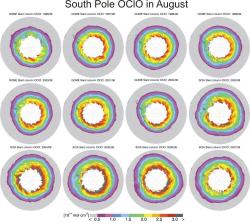Monitoring the stratospheric ozone layer using satellite measurements
Satellites provide continuous and global observations of a variety of atmospheric minor constituents, and are, therefore, of great importance for the global monitoring of the Earth's atmosphere. Satellite measurements of ozone are generally based on spectroscopic techniques exploiting the characteristic absorption or emission of electromagnetic radiation by the ozone molecules. Since the late 1970s the satellite instruments TOMS (Total Ozone Mapping Spectrometer) and SBUV (Solar Backscatter Ultraviolet) – operated by the National Aeronautics and Space Administration (NASA) – provide continuous measurements of the total ozone content in the Earth atmosphere.
Since 1995 the GOME (Global Ozone Monitoring Experiment) instrument on the European satellite ERS-2 (European Research Satellite-2) delivers global measurements of ozone and a series of other atmospheric constituents that are relevant for the chemistry of stratospheric ozone, e.g. nitrogen dioxide, NO2 and chlorine dioxide, OClO (see Figure 4). The amount of OClO is a measure of the chlorine activation (Cl radical production) that results in polar ozone depletion. Since March 2002 the GOME measurements are complemented by measurements with the SCIAMACHY (Scanning Imaging Absorption spectroMeter for Atmospheric CHartographY) on the European environmental satellite Envisat continuing observations of the chemical composition of the atmosphere to date.

|

|
- Fig. 4: (click for larger image)
- Left: OClO slant column observations above Antarctica from GOME and SCIAMACHY in August from 1995 to 2006.
- Right: the same but above Arctic during February from 1996 to 2007.
- The magnitude of the slant column is a measure of the chlorine activation by reactions on the surface of polar stratospheric clouds that is responsible for polar ozone depletion during polar spring. The chlorine activation has been at maximum levels in the southern hemisphere during the last decade. In the northern hemisphere the chorine activation is more variable depending on the meteorological condition. In cold Arctic winters like 1996, 1997, 2000, 2005, and 2007 chlorine activation was high, while almost absent in other years when warmer stratospheric temperatures prevailed. Similar to ozone, a reduction in the chlorine activation in the southern hemisphere is not yet evident.
The Institute of Environmental Physics (IUP) at the University of Bremen is the lead scientific institution for the GOME and SCIAMACHY satellite instruments. At IUP Bremen many atmospheric constituents and parameters are operationally retrieved from GOME and SCIAMACHY measurements, and are provided to the public via online data archives (GOME data archive, SCIAMACHY data archive). The continuous monitoring of the stratospheric ozone layer by European missions is guaranteed until 2018 through a series of GOME follow up instruments onboard meteorological operations satellites (MetOP).
(next page: contact and further information)
|
Institute of Environmental Physics (IUP) Institut of Remote Sensing (IFE) University of Bremen, Otto-Hahn-Allee 1 28359 Bremen Deutschland contact to the IUP |

|

|